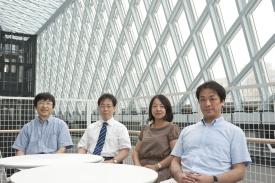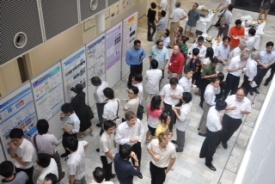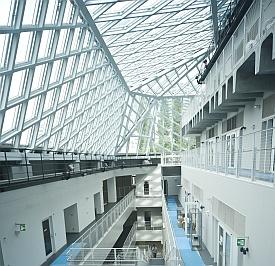

09/26/2011
As the technologies of the future become more elaborate and more reliant on the convergence of multiple, often wildly dissimilar fields of research, substantiating such cross-disciplinary collaboration as an integral part of the research culture has become more important than ever. Bringing together researchers from vastly different scientific backgrounds to work together effectively on the type of ‘fusion’ research that can lead to the next great innovation, however, requires more than casual collaboration.
When it was established in 2007, the WPI-AIMR at Tohoku University set out specifically to nurture fusion research on innovative functional materials by adopting an organizational and research structure that makes interdisciplinary collaboration a natural part of the work environment. After four years and a total of 44 fusion research projects, the institute’s reputation for innovative, cross-disciplinary materials-oriented research extends across the globe, attracting some of the world’s leading researchers in materials science.

The WPI-AIMR is now home to 119 researchers, about half of whom are from countries other than Japan, and many resolved to join the institute specifically because of its emphasis on innovative interdisciplinary research. “The fusion research we are carrying out here is creating completely new research fields, so it is much more than just simple collaboration,” says Naoki Asao, a professor at the WPI-AIMR’s Soft Materials Group since 2009. Asao carries out fusion research aimed at developing nanostructured hybrid metal catalysts. “Before coming to the WPI-AIMR, I had never heard of nanoporous materials during my career in synthetic chemistry,” he says. The opportunity to collaborate with Mingwei Chen, principal investigator of the Bulk Metallic Glasses (BMG) Group, however, has enabled Asao to hone his expertise in the production of nanoporous gold based on a process known as dealloying. The procedure involves treating a gold–silver alloy with nitric acid that selectively removes silver, leaving behind a nanoporous gold structure. Due to its remarkably high specific surface area, nanoporous gold is a material of emerging interest for the development of novel catalytic and sensor applications.
Most fusion research projects at the WPI-AIMR benefit from seed funding for one year, and the institute is rare in its provision of financial funding for such short projects. “This type of financial support allows younger researchers to concentrate on their projects without expending vast amounts of time and energy applying for research grants, thereby simplifying the whole procedure,” says Hongwen Liu, an assistant professor in the Materials Physics Group. Liu is currently developing plasmonic substrates that increase the efficiency of opto-electrical conversion. “I feel very fortunate to be working in an environment where the barriers that normally exist between fields are broken down, which allows younger researchers like myself to work on truly cutting-edge projects,” she says.
Fusion research enables researchers not only to learn about new scientific developments outside of their respective fields, but also gain a fresh perspective on their own work. “When I joined the WPI-AIMR’s BMG group after completing my PhD in nanotechnology, I had to approach metallic glasses from a physics point of view,” says Koji Nakayama, an associate professor of the BMG Group. Nakayama conducts research on the controlled fabrication of metallic glass nanofibers based on noble metals, which are characterized by exceptionally high damage tolerance. “In many ways, my time at the WPI-AIMR from the very start has been one ongoing fusion project,” he says.
The WPI-AIMR’s emphasis on maintaining open channels of communication encourages researchers to learn from others and lend a helping hand to colleagues and young researchers in particular. Takeshi Fujita, an associate professor in the BMG Group, notes, “A postgraduate student working on soft matter recently asked me about using nanoporous gold as a cell substrate. I was happy to assist because manufacturing nanoporous gold is my specialty.”

To facilitate the exchange of ideas among its researchers, the WPI-AIMR hosts seminars on a regular basis, and every week holds a ‘Tea Time’ event designed to spark lively scientific discussion in an informal setting. “These events not only encourage us to learn about what other people are doing, but also open our minds to other research fields,” says Liu. “If I ever go back to China, I would like to hold similar events for the benefit of my students and colleagues.”
With increasing demand for clean energy, the WPI-AIMR is intensifying its focus on developing innovative ‘green’ materials, such as reusable catalysts, solar cells and sustainable engineering solutions based on organic chemistry. Nakayama explains, “Green activities in Japan used to be concerned with how we can save the environment, but now they are more focused on how renewable energy devices such as solar cells with improved efficiency can be developed through materials science.”

Advances in nanotechnology, for example, are rapidly driving the development of next-generation charge-storage devices that improve on the performance of traditional lithium-ion batteries. Fujita, who has been investigating the electrical storage capabilities of supercapacitors using transition metal compounds, says, “We are aiming to develop a new type of battery that can be charged quickly using solar cells and which in the future may be compatible for use in mobile phones and electric cars.”
The WPI-AIMR's commitment to developing new forms of green innovation with a global outlook was reinforced by the ‘Cutting-edge Functional Materials for Green Innovation’ workshop held in February 2011, which attracted many internationally renowned materials scientists from the Asia-Pacific, Europe and North America.
By bridging the disciplines of materials science, physics, chemistry, biotechnology and engineering, the WPI-AIMR not only provides a unique environment that nurtures the development of breakthrough technologies, but also continues to promote international joint research projects and multidisciplinary exchange through its satellite centers and network of 19 overseas collaborative research institutions.